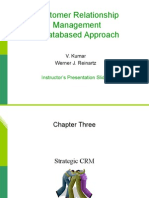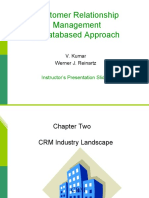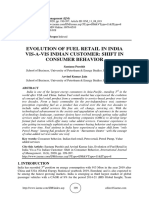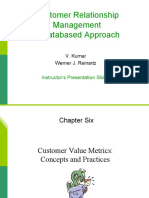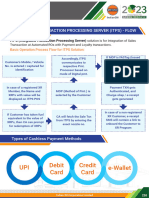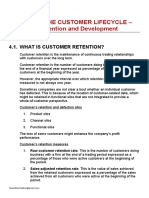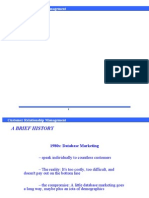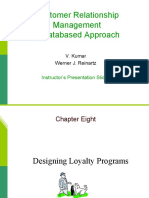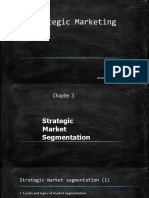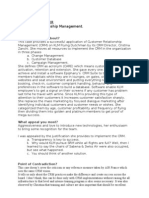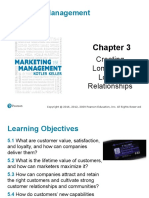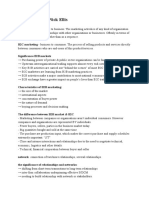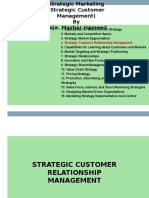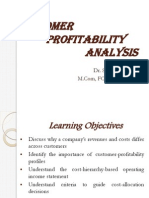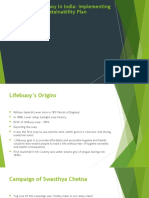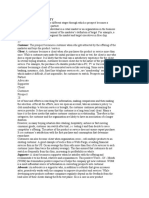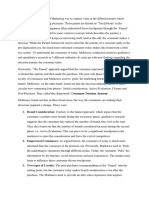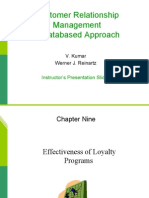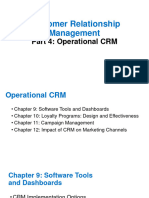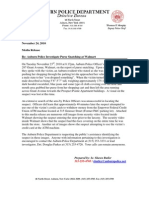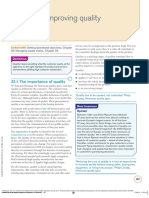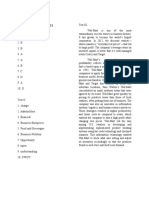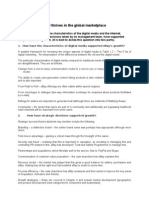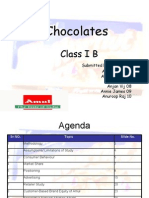Customer Relationship
Management
A Databased Approach
V. Kumar
Werner J. Reinartz
Instructors Presentation Slides
�Chapter Nine
Effectiveness of Loyalty
Programs
�Topics Discussed
Drivers of Loyalty Program Effectiveness
LP Design Characteristics
Achieving Competitive Advantage
The 7-Point Check List for Successful Loyalty Program Design and
Implementation
Minicases: Starwood Hotels
CRM at Work: Tesco
�Drivers of LP Effectiveness
Demand side:
Attitudinal
Loyalty
LP Design
Characteristics
Customer Characteristics
Market Characteristics
Firm Characteristics
!Word-of-Mouth
*Share of Category Requirement
Demand side:
Behavioral
Loyalty
Supply side:
Cost of
Loyalty
Program
LP Benefits to
Organization
1.Commitment,
positive WOM!,
Community,
True Loyalty
2. Efficiency
Profits:
Greater SCR*
or retention
3. Effectiveness
Profits:
Better value
proposition
through learning
4. Value
Alignment
�Loyalty Program Design Characteristics
Classified according to:
Reward structure
Sponsorship (existence of partner network, network externalities)
To know if an LP is effective:
From the consumers perspective, are rewards attainable?
From the consumers perspective, are rewards relevant?
From the firms perspective, is the LP design aligned with the desired
goal(s)?
�LP Customer Characteristics
Skewness of customer value distribution varies across industries
(value heterogeneity)
Similar usage and customer profitability of individual customers or accounts
(e.g.: gasoline industry)
Different usage and customer profitability of individual customers or
accounts
(e.g.: financial services or the telecom industry)
Value alignment feasible in industries such as airlines, hotels, rental
cars, pharmacies, telecom and financial services
�Market Characteristics
Market concentration (supply side)
Double jeopardy (Ehrenberg et al ): small market share brands suffer
because of two threats:
low share brands are purchased by fewer customers than high share brands
Repeat Purchase Probability
among those who buy the brand, they purchase it less often
1
Super loyalty
brands
0.8
0.6
0.4
0.2
Double
Jeopardy Line
0
0%
100%
Market Share
Source: Graham Dowling and Mark Uncles (1997), Do Customer Loyalty Programs Really Work? Sloan Management Review.
Summer 71-82.
�Firm Characteristics
Perishability of a product
Hotel LPs: frequent users get upgrades to better rooms subject to
availability. Upgrades are only given when there is excess capacity that
night. The reward of an upgrade comes at very low marginal cost
Airline seats
Breadth and depth of the firm offering the product at the store/retail
level results in higher efficiency profits because:
A buyer is more likely to fulfill his needs
A buyer has more opportunity for one-stop shopping (attributed to more
time saving)
A buyer has more opportunity for behavioral loyalty (attributed to more
purchase occasions)
�Achieving Competitive Advantage
Reason a firm develops a LP program is to achieve competitive advantage
Competitive advantage of a firm results in the ability to operate more
profitably over a sustained period of time
A highly frequented category like Grocery Stores is more likely to attract
members in to its LP
LPs with the goal of creating Efficiency Profits provide the smallest basis for
achieving competitive advantage
The value provided to the customers participating in a LP must be greater
than for customers not participating
Industries such as financial services or telecom can expect to reap
competitive advantage when pursuing a goal of value alignment
�LP to Achieve Competitive Advantage:
CRM at Work: Tesco
Launched the first LP in British supermarket industry in 1995 called Club
Card ; relied on incentive aspect of the loyalty scheme
Successful in capturing both market share and share-of category
requirements in subsequent years
Later established segmentation scheme of its customer base
Sends 80 different versions of its mailing to members and publishes four versions
of its clubcard magazine
Offers tailored cards to students, families, top customers, seniors, etc
Aligned its LP offering closely with the specific members needs as opposed
to giving out general incentives e.g. Tescos Baby club
Tesco merges information on customer transactions within Tescos website
and with point of sale data to customize its product offerings and
communications
�The 7-Point Check-list for Successful
LP Design and Implementation
Is your LPs goal compatible with marketing strategy?
Is the design of your LP aligned with the characteristics of your
market, customer base, and your firm?
Is cost management of LPs possible by mitigating costs via low
marginal cost rewards or via contributions from manufacturers?
For determining predicted benefits of your LP can you attempt a
trade-off analysis between cost and gains of the LP program?
�The 7-Point Check-list for Successful
LP Design and Implementation (contd.)
If LPs are withdrawn, design faults will not only result in
losses due to the program but have more lasting impact
in the form of customer dissatisfaction
Chances for strategic success of your LP are highest if
your goal is to achieve effectiveness profits in your marketing
operations
Do you have the necessary capabilities within your firm for LP
management? (e.g., data storage, data analysis, and learning)
�Loyalty Programs: Shackle or Reward
Loyalty programs as they exist today fall short in terms of creating attitudinal
loyalty
Loyalty programs focusing on incentives, deals, and promotions are often a
very costly proposition for the firm
LPs that are most likely to provide sustainable competitive advantage are
those that leverage data obtained from consumers into more effective
marketing decisions and thus result in true value creation for customers.
Loyalty is likely to follow
�Mini case: Starwood Hotels
Operates a customer loyalty program called Starwood Preferred Guest
(SPG) - allows customers to accumulate points for staying and spending with
Starwood
Unique - points never expire and Starwood does not have black-out dates
(dates when customers cannot use their points )
Challenges
Collection of too much information on individual customer behavior without
knowing how to use it, exacerbated by customers concern about privacy invasion
Very little knowledge over a large portion of its customer base; while roughly 7
million Starwood customers are members of the loyalty program, 6 million are not
Knowing the extent to which customers will tolerate frequent offerings; while
maximizing its cross-selling and up-selling opportunities
�Summary
The configuration and interaction of LP design, customer, market and firm
characteristics determines whether a LP achieves its desired objective
To know if a LP is effective, issues to be addressed include attractiveness of
LP, degree to which an accumulation of assets in the program is relevant,
and whether the LPs design is aligned with the desired firm goals
The key reason a firm develops a LP program is to create competitive
advantage
LPs that are designed to create Effectiveness Profits have the highest chance
of creating competitive advantage

